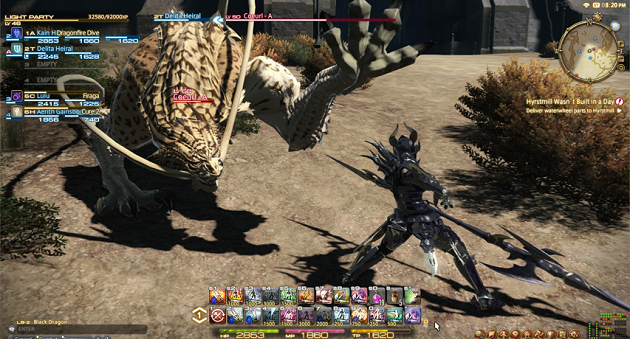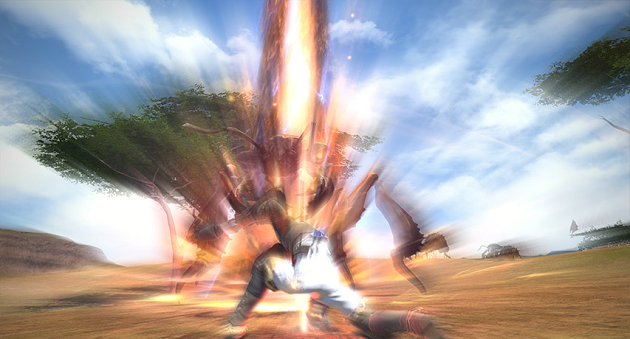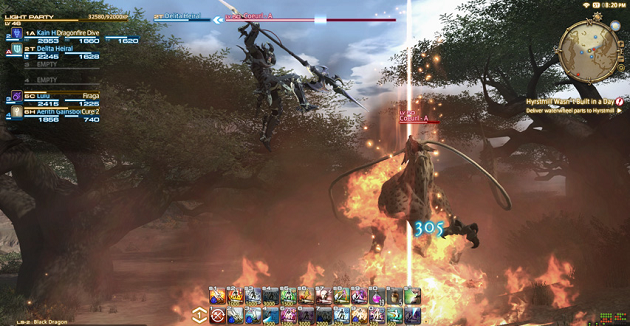Final Fantasy XIV:ARR First Impressions
As the realm of Final Fantasy XIV rises up from the ashes, join Corey Jenkins as he shares his adventures of the newly revived land of Eorzea
Killing Stuff, Final Fantasy Style
While there are a few noncombat quests scattered about, the majority of RPG players know that questing usually entails killing monsters of some sort, or fighting something or someone in some way.
 One of the first things I hear people say about the combat is that it feels too slow or static and they wouldn’t be completely wrong in that regard. Compared to most current MMORPGs that have begun adopting the ways of more action and movement-based combat; Final Fantasy XIV does feel a bit slower and more static.
One of the first things I hear people say about the combat is that it feels too slow or static and they wouldn’t be completely wrong in that regard. Compared to most current MMORPGs that have begun adopting the ways of more action and movement-based combat; Final Fantasy XIV does feel a bit slower and more static.
However, I will say that Final Fantasy fans should know that the series has never been about fast-paced action combat to begin with. In fact the upcoming Final Fantasy XV is one of the few titles in the series to really go that route. Final Fantasy has always been about slower more tactical turn-based combat. And while XIV is not fully turn-based I do think that they are going for the more tactical approach which long-time fans of the series are used to; offering unique abilities and ways to approach each encounter that also play off of how members of your party are fighting as well.
Starting off as a level 1 pugilist I only had a single combat ability on my bar, which was a basic 3-hit punch, along with a sprint that allowed me to travel faster. While I did have my standard auto attack accompanied by my one ability, combat did indeed feel a bit slow at first, even with the cool fighting animations. A few levels and a couple of quests in, I started to obtain more abilities. At about level 8 or 9 I started to see how deep the combat system could potentially go, even while soloing.
The main combat mechanic for Pugilists is their stances. After using certain abilities it puts you in a specific combat stance but, if you’re not in the stance required to use a certain ability, you can’t use that ability. In practice I would use my first skill that didn’t require a stance. This would then put me into my “Raptor Stance” which allowed me to use my second ability in the chain. After this second ability fired off I was then put into a third stance and was able to use my third and final ability in the chain which was my strongest and also gave me an attack speed increase.
As a Pugilist I didn’t do as much burst damage as a Marauder; however, what Pugilists lack in raw damage they make up for in speed, so getting my combo chains off was extremely important to playing the class properly. You might already start to gauge how complex skill-chaining as a Pugilist could become at higher levels, the abilities don’t stop there.

As a Pugilist I also received on-use abilities that weren’t attached to my global cool-down. I received an ability that allowed me to dodge more often, which was then paired with another damaging ability that I was able to use only when I dodged. So while chaining abilities on a mob that hits like a little kid with the flu sounds easy, keeping focus on using your abilities while chaining your attack skills on a monster that could cleave you in half is another story. It’s almost like an intense game of dance revolution, but with your fists.
While other classes had unique mechanics of their own the fundamental complexity and tactical nature of combat remained the same. It starts off slow, but the execution of combat and the difficulty increase of monsters makes combat a lot more tactical and engaging as you gain access to more skills. The tactical nature of XIV’s combat isn’t just bound to solo play. It comes into effect for group play as well.
Once you hit level 10 you have access to your first set of “guildhests”; part of the guildleve mission system meant for groups of players to complete and increase in difficulty the higher you go up in level. The initial guildhests are designed for groups of 4 players, which form a “light party”, and teach you how grouping works in Final Fantasy XIV. While light parties seem to be the standard party size, groups can become larger than that for the more difficult encounters and instanced raid-like dungeons in the game.

As the four of us gathered in a group, I immediately noticed a change in my UI. The obvious things were there such as my party members’ health, MP, TP etc. But we were also receiving stat bonuses by having a party filled with different class variations; a clever mechanic to help encourage grouping even with fewer than 4 members involved.
The coolest thing about grouping has to be the “Limit Break” feature that unlocks once you’re in a party of 4 or greater. While a light party or above, your party gets a Limit Break gauge which can be filled up based on several factors such as performing well in a fight or having a healer make a clutch heal on the tank at the last second. And, at least at low levels, filling that bar was no trivial task. However, If you manage to fill that limit gauge bar, your party gets access to a visually amazing and powerful group ability otherwise known as the Limit Break. What that Limit Break actually does though is ultimately determined by the person who activates it.
If a melee damage dealer activates it, it will do a high burst single target attack, if a tank activates it, it does a more defensive ability, if a ranged damage dealer activates it, then it turns into an AoE and if a healer activates it, it then becomes a powerful healing spell. So you can see the complexity of the system and how communicating and using it at crucial moments in the correct way, determined by each individual encounter, can prove to be rather engaging and challenging.
While my group did not actually get to see this being done first-hand you can check out the XIV limit break video below.
Moving back toward the basics of group combat, XIV uses the standard “holy trinity” system with a Tank, Healer and Damage Dealers. The first two guildhests are designed to teach you the basics of that system. They were a bit forgiving at low levels since our Gladiator tank had absolutely no idea what tanking was. Our first guildhest commenced with monsters every which way, the heals kiting and healing, and another Pugilist and me running around franticly trying to kill mobs and act as “off-tanks” to our more squishy robe wearing healer friend. The movement animations while getting off melee abilities could be a tuned in a lot more I think, but all in all it was a pretty fun and fast paced first experience.
Going in, I think the designers knew that many Final Fantasy fans may not fully grasp the concept of what a tank is supposed to do, since the second guildhest was almost made specifically for tanks to learn how to pick up aggro. Judging by how our initial hest went, it would have been nice if the “how to tank” hest was first, even though we managed to complete it. This hest went a lot better though, having the tank pick up a main boss and throwing adds a few at a time for him to grab as well; compared to the boss and the adds all at once like last time. This wasn’t anything too difficult, but already I could see some of the fundamentals I used while soloing at the starting levels begin to take form in group play as well.





